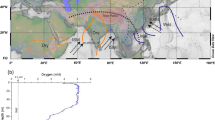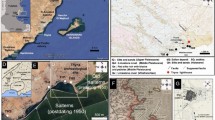Abstract—The lithological-facies zonality of the Neo- and Eopleistocene sediments from two main areas of the Andean submarine margin is described for the first time. Processing of corresponding maps and isopach schemes using A.B. Ronov’s volumetric method made it possible to calculate the quantitative parameters of sedimentation for distinguished types of Pleistocene sediments. Terrigenous sedimentation predominated and was intensified during the Pleistocene. The accumulation of biogenic opal in form of diatom frustules was more intense in the Eopleistocene than in the Neopleistocene. This is related to the activation of the Peruvian upwelling caused by the upwelling of the Antarctic Intermediate Water.






Similar content being viewed by others
REFERENCES
G. N. Baturin, Ocean-Floor Phosphorites (Nauka, Moscow, 1978) [in Russian].
J. H. Behrmann, S. D. Lewis, R. J. Musgrave, et al., Proc. ODP, Init. Repts. 141, (1992).
C. M. Clapperton, Quaternary Geology and Geomorphology of South America (Elsevier, Amsterdam, 1993).
S. L. D’Hondt, B. B. Jørgensen, D. J. Miller, et al., Proc. ODP, Init. Repts. 201, (2003).
L. A. Dukhova and V. V. Sapozhnikov, “Hydrochemical indicators of primary production in zones of Peruvian and Canary upwellings,” Tr. VNIRO 152, 85–100 (2014).
R. Gersonde, “The expedition of the research vessel “Sonne” to the subpolar north Pacific and the Bering Sea in 2009 (SO202–INOPEX),” Ber. Polarforsch. 643, (2012).
F. M. Gradstein J. G. Ogg, Smith A.G. et al., A Geologic Time Scale 2004 (Cambridge Univ. Press, 2004).
V. E. Khain, Tectonics of Continents and Oceans (Nauchnyi Mir, Moscow, 2001) [in Russian].
R. Kilian and J. H. Behrmann, “Geochemical constraints on the sources of South Chile Trench sediments and their recycling in arc magmas of the Southern Andes,” J. Geol. Soc. London 160, 57–70 (2003).
F. Lamy, D. Hebbeln, and G. Wefer, “Terrigenous sediment supply along the Chilean continental margin: modern region patterns of texture and composition,” Geol. Rundsch. 87, 477–494 (1998).
M. A. Levitan, “Comparative analysis of pelagic Pleistocene silica accumulation in the Pacific and Indian oceans,” Geochem. Int. 54 (3), 257–265 (2016).
M. A. Levitan, A. N. Balukhovsky, T. A. Antonova, and T. N. Gelvi, “Quantitative parameters of Pleistocene pelagic sedimentation in the Pacific ocean,” Geochem. Int. 51(5), 345–352 (2013).
M. A. Levitan, T. N. Gelvi, K. V. Syromyatnikov, and K. D. Chekan, “Facies structure and quantitative parameters of Pleistocene sediments of the Bering Sea,” Geochem. Int. 56(4), 304–317 (2018a).
M. A. Levitan, T. N. Gelvi, and L. G. Domaratskaya, “Facies structure and quantitative parameters of Pleistocene sediments of underwater continental margins of the Wilkes Land and Ross Sea, Antarctica,” Vestn. Inst. Geol. Komi Center Ural. Otd. Ross. Akad. Nauk, No. 10, 17–22 (2018b).
F. W. McCoy, T. R. Swint, and D. Z. Piper, “Types of bottom sediments,” International Geological–Geophysical Atlas of the Pacific Ocean, Ed. by G.B. Udinstev (Inyergovernmental Oceanographic Commission, Moscow–St. Petersburg, 2003), pp. 114–115.
A. C. Mix, R. Tiedemann, P. Blum, et al., Proc. ODP, Init. Repts. 202, (2003).
D. R. Montgomery, G. Balco, and S. D. Willett, “Climate, tectonics, and the morphology of the Andes,” Geology 29 (7), 579–582 (2001).
I. O. Murdmaa, Ocean Facies (Nauka, Moscow, 1987) [in Russian].
A. B. Ronov, History of Sedimentation and Fluctuations of the European USSR: Volumetric Method Data, Tr. Geofiz. Inst. Akad. Nauk SSSR, No. 3, (1949).
N. M. Strakhov, “Comparative–lithological direction and its tasks,” Byull. Mosk. O-va. Ispyt. Prir., Otd. Geol. 20 (3/4), 34–48 (1945).
E. R. Suess, von Huene, et al., Proc. ODP, Init. Repts., 112, (1988).
V. G. Trifonov and S. Yu. Sokolov, “On the way to post-plate tectonics,” Vestn. Ross. Akad. Nauk 85(7), 605–615 (2015).
www.gebco.org (2004)
Funding
This paper was partially supported by the Russian Foundation for Basic Research (project no. 17-05-00157) and Presidium of the Russian Academy of Sciences (program no. 49P). This work was performed in the Framework of State Task no. 0137-2016-0008.
Author information
Authors and Affiliations
Corresponding author
Additional information
Translated by M. Bogina
Rights and permissions
About this article
Cite this article
Levitan, M.A., Gelvi, T.N. & Domaratskaya, L.G. Facies Structure and Quantitative Parameters of the Pleistocene Sediments of the Andean Submarine Margin. Geochem. Int. 58, 435–446 (2020). https://doi.org/10.1134/S0016702920030076
Received:
Revised:
Accepted:
Published:
Issue Date:
DOI: https://doi.org/10.1134/S0016702920030076




